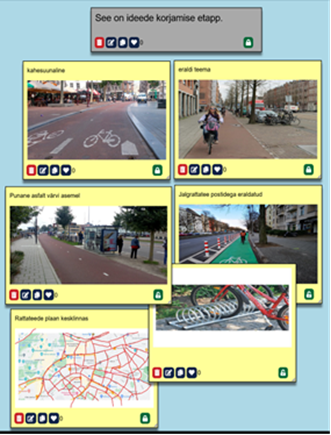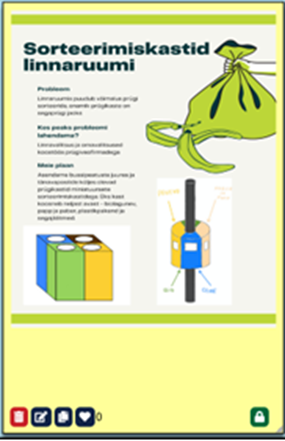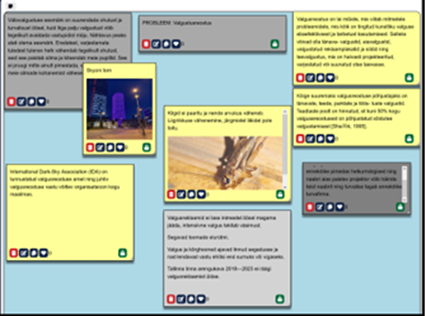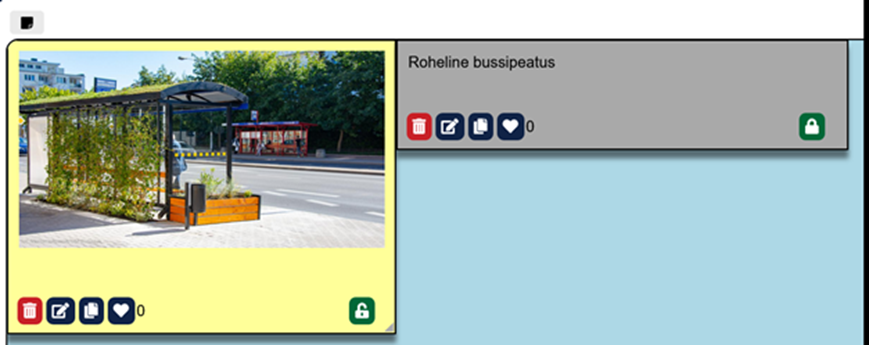
Description of the course
The purpose of project day in the German Gymnasium in Tallinn was to introduce Tallinn University and its activities and programs. The project week is run for high-school graduates to prepare them for university entrance. The aim is to support the development of students’ various competences towards resolving interdisciplinary problems in tertiary education. During the project week, projects are implemented in collaboration among university educators and students.
Description of the participants
The ICT-INOV methodology was deployed on April 18, 2022 for a day-long workshop course. A total of 35 students from Kadrioru Saksa Gümnaasium were engaged in the course. Participants were high-school graduates from 2 separate classes.
Description of gamified design thinking activities
A learning activity based on gamified design thinking was specifically designed for the course. The objective of the learning activity was to challenge students to become aware of sustainability problems in their everyday lives and to propose solutions.
Students worked in groups of up to 7 individuals. The ICT-INOV digital learning platform provided instructors with flexibility on structuring learning activities based on well-accepted design thinking steps. The activity was structured as follows:
Step 1: Problem discovery
Students were instructed to identify sustainability issues in their everyday lives over the timespan of a week as homework prior to the project day.
Step 2: Design thinking methodology and sustainability
Triinu Jesmin and Jaanus Terasmaa started the day with presentations about sustainability and the introduction to design thinking methodology.
Step 3: Problem definition
Students were encouraged to post the main sustainability challenges that they identified over the duration of the week leading up to the workshop to the ICT-INOV digital learning platform. They subsequently had a discussion with their peers through which they selected a joint problem to be addressed by the entire team. They accurately defined the problem and posted it on the platform.
Step 4. Research
Students were encouraged research on-line information that helps describe the problem in focus through text, images, and videos. They described a characteristic individual that faces the problem, the problem causes, what has been done about it, and why suggested solutions have failed so far.
Step 5: Brainstorming and ideation
Students were further encouraged to post as many ideas as possible towards a solution. Students collaborated with their team members to design and post on the ICT-INOV digital learning platform platform their proposed solutions. They used the results of the research step as inspiration towards innovation.
Step 6: Prototyping
Students created either paper or digital prototypes of their proposed solutions and posted them on the ICT-INOV digital learning platform.
Step 7: Presentation
Students deployed the ICT-INOV digital learning platform for posting their presentations before they presented their solutions to the class and mentors.
The projects that students worked on were the following:
- Red asphalt bicycle roads. Improving bicycling experience in Tallinn by introducing safe and environmentally friendly red asphalt roads.
- Intuitive and nice looking recycle bins. Introducing recycling bins with attractive and intuitive design to encourage further recycling.
- Reducing light pollution. Saving energy and promoting safety for all living beings.
- Pedestrian areas. Designing a new Tallinn city center in which central streets are closed for motor vehicles. At the same time creating enticing pedestrian areas.
- Greener Tallinn. Making the city center more environmentally friendly by building green/living bus stops.




